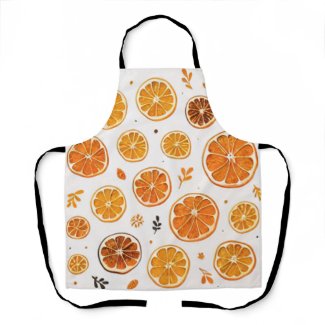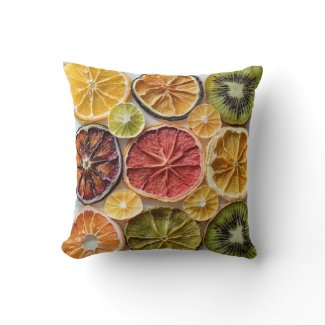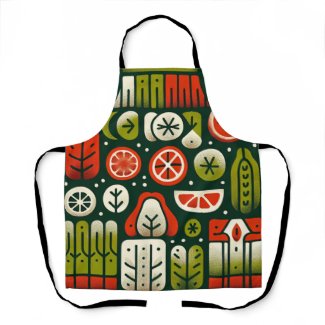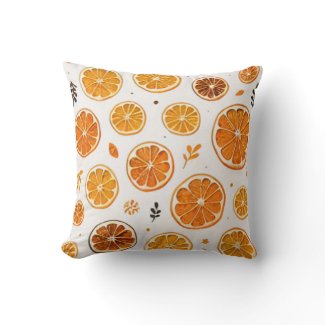- Home
- How To Dehydrate Vegetables
- How to Dehydrate Butternut Squash
How to Dehydrate Butternut Squash
(Fresh or Frozen)

Susan Gast | Author and blogger at Bored Boomers, Beesville Books, A New Sober You and Easy Food Dehydrating
Today, I'm gonna show you how to dehydrate butternut squash! Although butternut squash can be difficult to peel, it's well worth the effort!
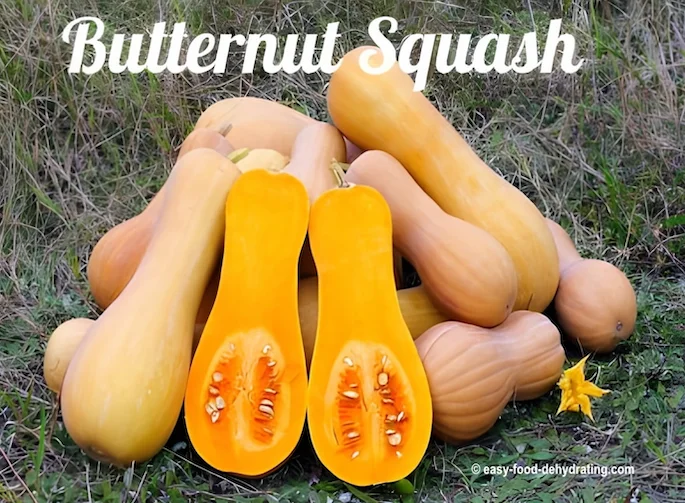
I use this veggie all the time in our doggie's dinner. Read more about making your own dog food here.
What’s Inside Butternut Squash? (Hint: Lots of Good Stuff!)
VITAMINS: Loaded with Vitamin A. Also contains Vitamin C, Folate, Vitamin E, Vitamin K, Niacin, and trace amounts of Pantothenic Acid and Thiamine, so it's well worth your time and energy.
MINERALS: Potassium ranks high, followed by Calcium, Magnesium, and Phosphorus, with trace amounts of Selenium, Manganese, and Zinc.
Butternut squash also contains Omega-3 and Omega-6 fatty acids.
Step-by-Step: How to Dehydrate Butternut Squash at Home
If using frozen butternut squash, ignore steps 1 and 2.
- Peel the butternut squash and cut into 3/4-inch strips, or cube it for good even-drying.
- Steam over boiling water for about 7 minutes, or until your squash is tender.
- Arrange the butternut squash on your dehydrator trays, making sure the pieces don't overlap each other.
- Turn on your food dehydrator and set the temperature between 125°F and 135°F (or per your food dehydrator's instructions) and that's all there is to it!
💡 Tip: Use our Fahrenheit to Celsius converter here on our site!
- Drying time: between 7-10 hours.
- Butternut squash will be leathery in consistency when dried.
- Please remember to rotate your dehydrator trays for even drying.
Save Time: Why Frozen Butternut Squash is a Game-Changer
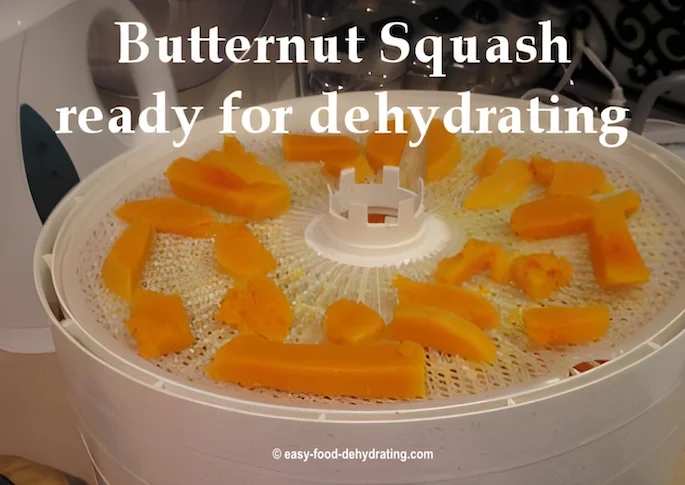
As noted in the instructions above, butternut squash is steamed
lightly first, to aid in the dehydrating process. This softens them and breaks down the outer edges, allowing moisture to escape faster. It also helps keep the squash's vibrant color!
Butternut squash makes a great soup and purées well for sauces.
As I mentioned at the top of this page, my primary use of butternut squash is for my Chicken Chow dog food for our perfectly adorable Miniature Pinscher!
I'd like to make a note here that I have not tried dehydrating puréed frozen butternut squash, but I think it would work just fine on the fruit roll sheets! Just let it thaw out first and follow the temperature guide below...
Pro Tip: Uniform Cuts = Faster, Even Drying
I would like to add here that it's better to have even-sized pieces of the squash on the dehydrator trays—it dries out better and at the same rate, so you're NOT taking off the small pieces and still running the dehydrator to finish drying the larger pieces.
Don't let my photo of
the bigger piece of butternut squash on the dehydrator tray (shown in the previous section) lead you astray. Oops, sorry about that.. a case of "do as I say, not as I do!" LOL :-)
Ready to Steam: Prepping Squash for Dehydrating Success
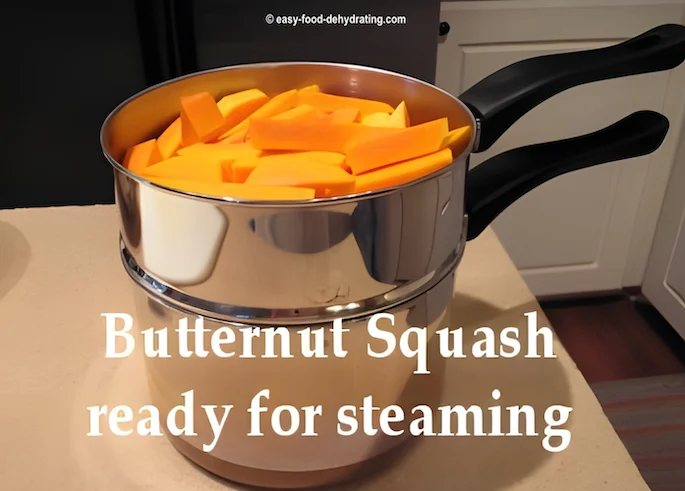
What Perfectly Dehydrated Butternut Squash Should Look Like
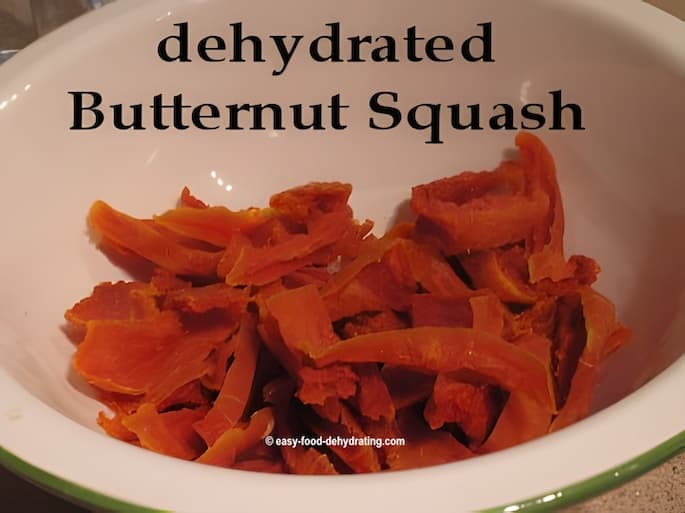
Different Types of Butternut Squash—Which One’s Best?
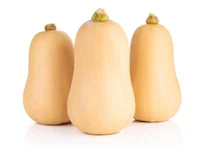
There is more than one type of butternut squash.
The most common type of butternut squash is the Waltham Butternut Squash.
This type of squash is large and oblong, with a yellow-orange color. It has a sweet, nutty flavor that makes it perfect for soups, stews, and pies.
Another type of butternut squash is the Buttercup Squash. This type of squash is smaller and rounder than the Waltham Butternut Squash. It has a greenish-yellow color and a sweeter, more delicate flavor. It is often used in baby food because of its smooth texture.
Finally, there
is the Pumpkin Squash. This type of squash is small and round, with an
orange-yellow color. It has a mild, sweet flavor that makes it perfect
for pies and other desserts.
Where Does Butternut Squash Grow Best?
The best areas to grow butternut squash are in warm climates with well-drained soils. Butternut squash is a warm-weather crop, so it does not do well in cold or damp conditions. Additionally, butternut squash needs full sun and well-drained soil to thrive.
So, if you're looking for the perfect spot to grow butternut squash, make sure it is in a warm climate with full sun and well-drained soil.
Butternut vs Pumpkin: Are They Cousins?
Butternut squash is related to pumpkin. They are both members of the gourd family. Butternut squash is actually a type of winter squash, which is a group of squash that is characterized by its hard skin and sweet flesh.
Pumpkin is also a type of winter squash, but it is more commonly used for carving than for eating. So, while butternut squash and pumpkin are related, they are not the same.
Now you know how to dehydrate butternut squash and pumpkins, I'd love to hear from you! Contact me here and share your recipe!
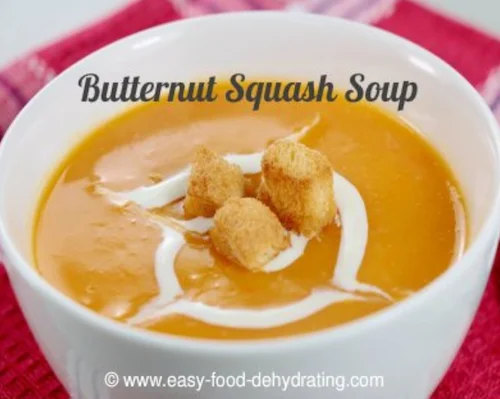
Use Your Dehydrated Squash in This Delicious Soup
If you want to try your hand at making butternut squash soup, check out this Butternut Squash Soup recipe from AllRecipes.com
The photo is NOT from their website, but you use it for serving inspiration!
Butternut Squash Dehydrating FAQ
How do you dehydrate butternut squash?
How do you dehydrate butternut squash?
Check out the full step-by-step process above—including prep tips for fresh and frozen squash!
Can I use dehydrated butternut squash in soup?
Can I use dehydrated butternut squash in soup?
Absolutely! Just rehydrate it in hot water or broth for 10–15 minutes. It’s perfect for soups, stews, and purées.
Can dogs eat dehydrated butternut squash?
Can dogs eat dehydrated butternut squash?
Yes! Butternut squash is safe for dogs in small amounts and is a healthy fiber-rich veggie to include in DIY dog food. I use butternut squash to make my doggies "chicken chow" dog food. Read more about that here.
Can I dehydrate puréed butternut squash?
Can I dehydrate puréed butternut squash?
Yes! Use fruit leather trays in your dehydrator. Spread the purée evenly and dry at 135°F until it’s leathery (about 6–8 hrs).
What’s the best way to store dehydrated butternut squash?
What’s the best way to store dehydrated butternut squash?
Store in airtight glass Mason jars or vacuum-sealed bags in a cool, dark pantry. Use oxygen absorbers for long-term storage.
How do I dry butternut squash seeds for planting?
How do I dry butternut squash seeds for planting?
Scoop, rinse, dry, and bake seeds at 200°F for 2–4 hours. Store in a labeled envelope in a cool, dark place for up to 1 year.
Get Your Free Guide to Dehydrating Like a Pro!
Don't forget to grab your free Six Simple Steps eBook! It’s packed with tips for dehydrating everything from fruits and veggies to dog treats. Get it here.
Before You Go...
If you like the content, please give me some love by clicking on the 🩷 in the lower right hand corner (on just about all my pages). This signals to me that you find it enjoyable and useful. Thank you so much!











